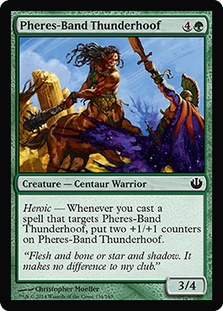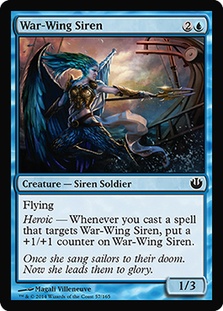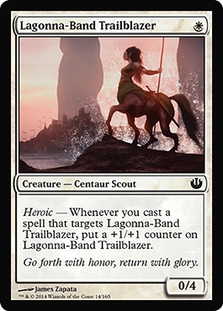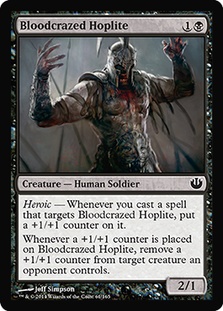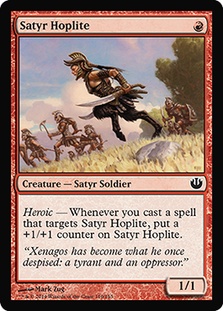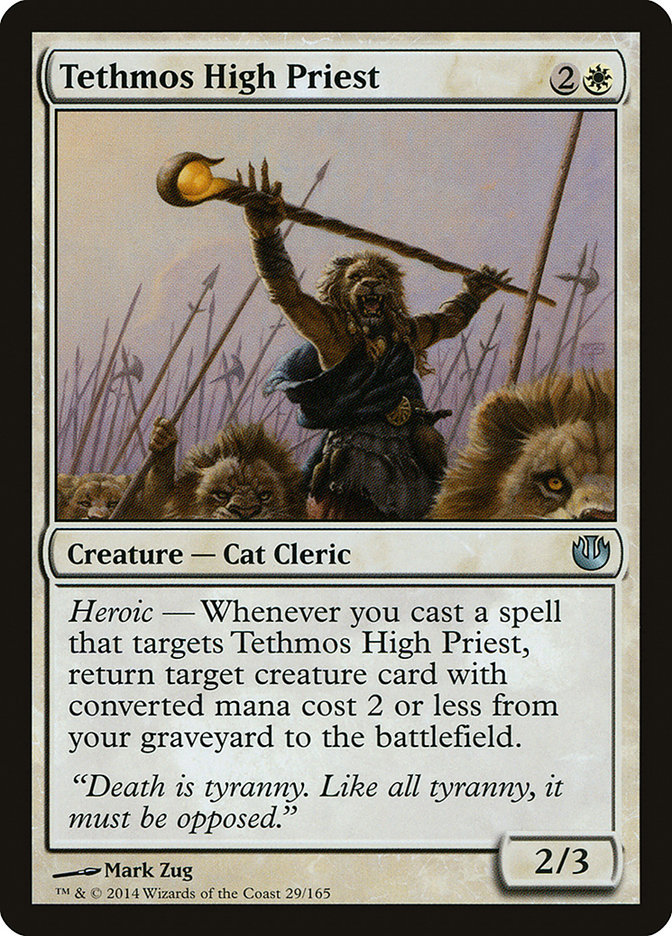Originally I wanted to talk about a sealed deck pool that I received a few weeks back. The format has changed since then, but I will include the pool as a
warmup excercise. Often I will receive a card pool that is capable of splashing cards via Nylea’s Presence and the like, but I won’t have anything worth
splashing, and you’re probably thinking “Aww, poor Josh.”
I know, I know.
Anyway, this was absolutely not the case. I spent the full amount of time during deckbuilding on this one and still don’t know if I got it right. In fact,
I switched colors and cards frequently after Game 1 of most rounds. This of course made me wistful for the relative ease switching decks or colors in Magic
Online, but alas, we don’t have nice things. Here’s the pool:
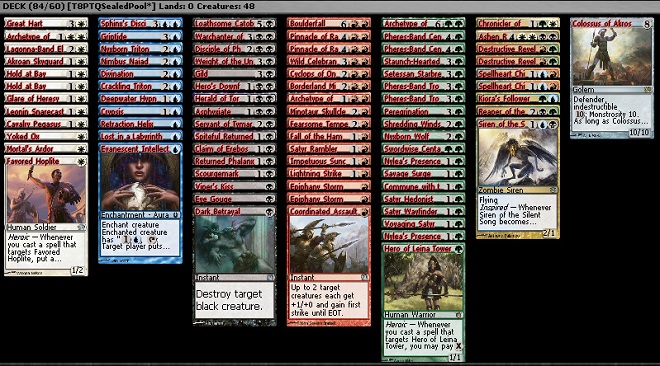
I’ll include my build of this deck at the end with a brief discussion of my thoughts. The reason I didn’t write about this deck is because a new set was
released! With Journey into Nyx comes a new limited format. Currently, it’s also the PTQ format, which means that if you’re interested in playing in the
Pro Tour, this is very important to you. Now, I’ve already extolled the virtues of the set for Constructed in my previous article, but that article does not really scratch the
surface of how the cards play in the Limited format. It’s easy to think Banishing Light is a high pick in draft because it was previously when it was
simply Oblivion Ring and it will continue being great for the foreseeable future. That being said, there is a lot more to the story than just something as
simple as that.
Now, I’ve already spent a lot of time discussing this Limited format, so I recommend reading over this article that was about the Born of the Gods Sealed format and perhaps this one
about just Theros Sealed in case you want my thoughts leading up to
this newer one.
But, now things are different. There are, by my count, twelve instances of Heroic in Journey into Nyx, and while I have not counted for the previous sets
it’s plain to the eye that the Heroic triggers in Journey are different.
These cards are all heroes in the normal sense of the word, as they gain counters, and they’re commons. The gaining of counters is a very dangerous Heroic
trigger, as it makes the game very hard for one player to get back into, perhaps even as early as Turn 2; in the “old days,” a Turn 1 Favored Hoplite and a
Turn 2 Ordeal spelled nearly certain doom. If I lead Satyr Hoplite into Ordeal, I’m looking good, but it’s not quite as absurd as it used to be. This is
also not to mention the fact that there are a full 66% fewer Ordeals at a table compared to the triple Theros days.
These two cards have utility triggers:
Both of these cards can range from playable to great depending on the composition of the decks being played against each other. I’m not sure how high of a
pick Leonin Iconoclast is in draft, but since we’re looking at Sealed, it doesn’t quite matter as much. I think it’s an auto-include in a Sealed deck
because people can only play what they open, and by-and-large they are going to open “enchantment creatures.” Some of them will have bestow and require
some work to actually fall prey to the Iconoclast, but some of them like Dreadbringer Lampads or even Doomwake Giants will sit and be relatively easy
targets if things come together for you. Obviously, Tethmos High-Priest will require you to have a plethora of creatures that you can return, and it will
also require your opponent to be actively killing off or trading with your two-drops. I think this is an OK card to start in Sealed, or a good sideboard
card if everyone is playing small creatures (to trade with each other) or your opponent’s deck is removal-heavy.
The rest of the Heroic triggers range from scary to cool, but the rarity is higher and won’t come up as often. Obviously, if your opponent has a
Dawnbringer Charioteers you’re going to feel bad, perhaps as bad as any Wingsteed Rider or Fabled Hero has ever made you feel, but at least it will come up
less often.
However, this is only half of the equation. As I mentioned above, you need the Ordeal to go with Favored Hoplite. W for a 1/2 creature was a fine deal even
just a couple of years ago, albeit not one people were interested in. Now, of course, Favored Hoplite has a ton of game text. That game text requires you
to target it with a spell. The best way to do this is to bestow onto it, or play something like a Chosen by Heliod or a Dragon Mantle. There are six cards
with Bestow in Journey into Nyx and none of them are commons; one is even a rare. The five uncommons have a drawback ranging from significant (as in “I may
not want to even bestow this”) to a nuisance, something that will change the way you play but not lose you the game. The cards are nice, don’t get me
wrong, as you can bestow your opponent’s creatures and knock them out or force them to attack or block. Speaking of which, the sixth bestow creature is
Hypnotic Siren, basically a Control Magic and not something you’d like to put on your own creatures.
So, while some things have remained the same (blocking is difficult and removal is not that plentiful or good), some things have clearly changed. In
general you will face far fewer heroic creatures that will beat you outright, and as such, I believe the format has slowed down a bit. It might be
realistic now to try to grind out your opponent with cards like March of the Returned and Font of Return. Now, I say “might” because I’m not an expert, nor
have I succeeded thus far in this format (currently 0/1 in PTQ T8s in this format), but I’m on a journey to learn as much as I can and do as well as I can
in the format, and hopefully find myself playing in the Pro Tour in Portland.
I had premonitions of getting passed a Master of Waves in this tournament. Unfortunately, I didn’t get passed anything nearly as good. Let’s take a look at
my sealed deck pool for this PTQ:
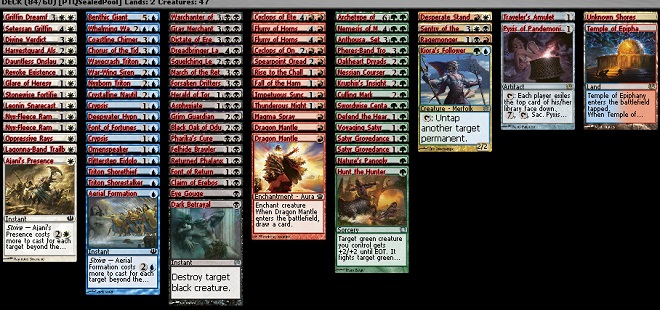
As we mentally check the decklist to make sure we didn’t receive a misregistered pool, we can see that some of our cards are very good (Herald of Torment,
Dictate of Erebos) and some of our cards are not that good (the entire color of red, for example). As we finish up that mental exercise, we see that not
only does black contain two of our very best cards, it is also our deepest color and one that we’ll simply have to play in this tournament. That means
we’re looking at a lot of waste, especially the Kiora’s Follower I was eyeing during the real-life version of this exercise. In my opinion, Kiora’s
Follower is one of the best early-game creatures in the format. Not only does it do its best Voyaging Satyr impersonation in the early game, but later on
it works well to give your big creatures mock-vigilance (you can untap them so they can block after they’ve attacked) and can wreak havoc on your opponent
with inspired-based tricks (like Deepwater Hypnotist, for example) in the mid-game. Also worth noting: while this is an “on-board” trick, it can still get
some people!
As we already know we cannot use the red to supplement our black, we must look to the other colors.
Green gives us a nice curve:

Each possible build has its own problems. None of the decks completely avoid playing “bad cards,” so we can only hope to minimize them. Bad mana is another
concern, since so many of the good black cards were double-black. I was definitely not excited once the entirety of this pool sunk in. I knew it was
lacking in just about every department, and I briefly thought about how I had “blown it” last time, when my Sealed deck was actually quite good.
This is the build I actually used during the event. I was not happy with any of the builds, but I felt this one had a few things going for it. First, it’s
the most aggressive of the three possible builds (and we’ll look at the other two in a bit). The fact that it’s aggressive means that my opponents would be
more often forced to block and trade with my creatures (when they could) which would in turn “activate” my graveyard recursion (Font of Return and March of
the Returned). I also had Forsaken Drifters, which I felt would do double duty being an aggressive card (four power, two toughness) and an easy enough way
to turn its “downside” of milling myself for four into an upside. I had two ways to break through with intimidate (Warchanter and Dreadbringer Lampads),
and while I didn’t have a ton of combat tricks, I did have access to all of my removal spells.
Anthousa wasn’t going to shine here and I didn’t have anything as good as Nessian Asp or Time to Feed, but I had some action. I also felt that being in a
position to force my opponents to interact with my creatures was a place I wanted to be. If they’re going to have to make combat decisions, then for the
most part, I am comfortable knowing that I will be able to make combat decisions better than my average PTQ opponent. Forcing your opponent to interact
with you is very powerful and not something that everyone is thinking about when they’re building their sealed decks, but I do think it’s a real thing that
is worth considering when you don’t have other options. Note: ordinarily I’d consider splashing when a pool was this weak, but honestly I felt I didn’t
have any options, as just Fall of the Hammer and Magma Spray are splashable removal spells, though situationally good. With the Swordwise Centaur and the
double-black cards, I didn’t think I could afford to splash at all.
The next build is the one I think I should have gone with:
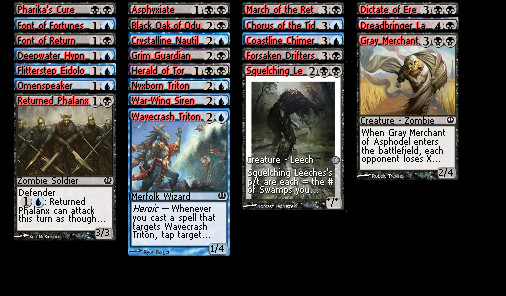
This deck gets to play the Temple, which is a great draw to the deck. Again, we have all the good black cards we’re trying to maximize in this pool. The
blue cards enable us to play Returned Phalanx to its fullest ability (rather than just a strong blocker, which would be a sideboard card for the most
part). Compared to the green, we lose out on our aggressive two-drops (Swordwise and the Gravedancers) but we get good defensive countermeasures like
Omenspeaker and then up the curve with Wavecrash Triton. This deck also has a lot more fliers than the G/B deck (obviously, just the Herald there) or the
B/W deck that we’ll look at next. Not a ton of ways to trigger heroic here, but the War-Wing Siren will be effective in this deck as a blocker, and if you
can trigger it even once, your removal and blockers just need some kind of clock to pressure your opponent and win while your defensive cards attempt to
control the board.
This deck is neither the best aggressive nor defensive deck of the bunch, but I do think it’s the most well-rounded. It has fewer holes, slightly fewer bad
cards and a little more card advantage in Font of Fortunes. Playing the B/G deck, I was definitely afraid of fliers but felt I had no choice. This deck at
least has some of its own fliers to block with. I’m playing Black Oak of Odunos in this deck as a really great blocker. It’s also a wonderful Inspired
enabler (and we have two decent Inspired creatures). In some cases, if the Warchanter gets “active” it cannot be stopped, and sometimes the only way your
opponent has to stop it is Divine Verdict, especially if they’re not playing their own black or red cards.
Overall, while this deck is not particularly strong, it is one of the stronger options in this pool. It’s important to remember that the goal of building
any Sealed deck (good or bad) is to maximize the strengths and minimize the weaknesses. In this case we have more bad than good, but we can still attempt
to give ourselves a nice chance to outplay our opponents.
Finally, we can look at the B/W build:
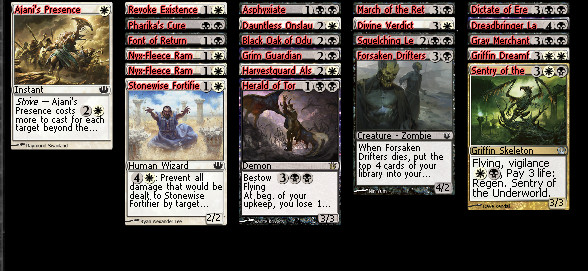
This is the grindiest, most defensive of the options, and might not have ever been right as a main deck configuration. The two Nyx-Fleece Ram are
particularly narrow in their applications, yet they are the cornerstone of this strategy. If my opponent had only ground creatures and no flying heroic
creatures, this is probably a great option to consider. Ordinarily you would expect to play a Leonin Snarecaster maindeck in a white deck in a normal
Sealed event, or at least you’d want to, but this deck doesn’t need or want a 2/1 ground creature. The interesting part about playing the 0/5s is that your
opponent may not be able to attack into them, which will gum up the ground; this in turn will make a 2/1 for two completely blank, and I just want to take
the opportunity to point out that sometimes it isn’t right to play all of your “good cards.” In Sealed, “good cards” are subjective, and not every white
deck will have an aggressive curve with Wingsteed Riders and the like.
Of course, that is what you hope to have, and I’m not saying that this deck is better than a deck that may feature multiple Wingsteed Riders. The good
parts of this deck are an extra removal spell (Divine Verdict), some difficult-to-play-around combat tricks (Ajani’s Presence and Dauntless Onslaught), and
another amazing win condition in Sentry of the Underworld. Griffin Dreamfinder makes it so that you can go somewhat infinite with your Font of Return,
essentially never having any of your creatures stay permanently dead.
In reality, that is all probably too slow, and while the Rams could easily shore up the ground in the early game, it isn’t clear to me that this deck would
be able to take advantage of a stalled board state every time, as it is lacking the huge powerful bombs (think Elspeth, Sun’s Champion or something like
Hythonia the Cruel) or the flying creatures to really take advantage of a stalled ground state. The most important thing to realize about this deck (and I
thought of this during the tournament) was that if my opponent had a God or a God’s weapon, I’d be up a creek unless I had boarded into white, or at least
had the foresight to splash the Revoke Existance and maybe the Divine Verdict off the Unknown Shores and the Traveler’s Amulet. It’s worth noting that this
deck absolutely does not minimize the “bad cards,” and in addition to some of the mediocre creatures that we can’t avoid, we also have to play some other
ones like Griffin Dreamfinder and the Harvestguard Alseids. It would be nice to be able to remove the emotional aspect of Magic, but it is a real thing and
unfortunately anyone who tells you otherwise is not being honest with themselves. Drawing these cards, the bad ones, not to mention the Forsaken Drifters
and his friends, can have a real drain on one’s “hopefulness” throughout the day.
So, to sum up, B/G was the deck that I felt gave me the best chance to win in the field at the time. I think I should have more fully explored the U/B
option, which looks the best to me in hindsight, or perhaps splashing. Originally I had planned on writing this in the style of the aforementioned “Theros
Sealed Seven Ways” article, but due to the timing of the Pro Tour, I was unable to really get answers from many of the people I wanted to ask, since they
were all too busy testing. I do understand that, of course, and cannot fault anyone for not spending the time on answering me. However, Reid Duke felt he
could spare ten minutes for my questions and he was rewarded with a Pro Tour Top 8.
Coincidence? I don’t think so.
Bonus Section #1: Reid Duke’s Build
“Black is the color that jumps out, since it has your two bomb rares, some removal, and a decent depth of playable cards. I next looked at red, since your
best red cards (Fall of the Hammer and Magma Spray) are probably better than any single other card that the other colors offer; however, the most important
aspect of a good Sealed deck is a strong creature base, so I settled on green as a second color. I splashed Fall of the Hammer because the deck is a little
short on playables and playing Temple of Epiphany is convenient to go with Returned Phalanx.”
Creatures (15)
- 1 Nessian Courser
- 1 Anthousa, Setessan Hero
- 1 Gray Merchant of Asphodel
- 1 Returned Phalanx
- 1 Voyaging Satyr
- 1 Nemesis of Mortals
- 1 Herald of Torment
- 1 Pheres-Band Tromper
- 1 Swordwise Centaur
- 1 Dreadbringer Lampads
- 1 Grim Guardian
- 1 Oakheart Dryads
- 2 Satyr Grovedancer
- 1 Squelching Leeches
Lands (17)
Spells (8)

I can fault neither Reid’s logic or build. He came to mostly the same conclusions I originally did, but was slightly less interested in the long-game grind
(with March of the Returned and Forsaken Drifters) than I was. I think I personally underrated how good playing a Temple would have been in this pool, as I
do have two cards that are significantly better than the other 38 cards in my deck, and it’s possible he would have recommended playing it as an off-color
land in some of the builds. That’s a question I wish I had asked him, actually.
BONUS SECTION #2: Previous-Format Sealed Deck
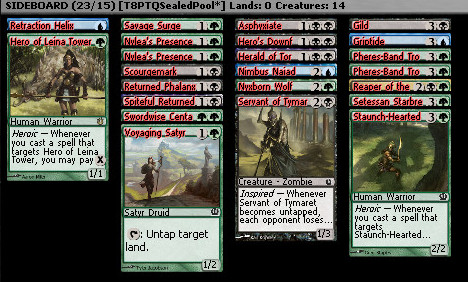
This is the build I registered. As I said I had spent the full amount of time building and had decided I wanted access to the blue to give me some answers
to bigger threats. Bouncing them could provide me with tempo that I might be able to use to win before cards like Shipbreaker Kraken, Arbor Colossus, and
perhaps even Hythonia beat me. In reality I didn’t face any of those cards. I ended up boarding into a Jund deck in most games. The question was usually
whether or not I wanted access to Destructive Revelry.
I felt the red in this pool was quite strong with two Pinnacle of Rage, which I think is mediocre to bad in Draft but quite strong in the slower Sealed
format, where card advantage can actually matter. I was torn on how to build this deck, and while I told you I was spoiled by having a good deck full of
options here, it really was hard to build. I looked at Black/Green with a Red splash and a Blue splash, and I also looked at a straight Blue/Green deck
that touched Red for the four cards I boarded in most rounds (Strike, Fall, Destructive Revelry, Destructive Revelry). This deck also splashed for the
Reaper of the Wilds and the Gild, courtesy of the two Nylea’s Presences that my pool benefited from so greatly. I do think the curve might have been a
little worse, possibly with too many four-drops. Despite getting to play with Kiora’s Follower, the deck made me bench two more black rares, which I was
unhappy about. I’m glad I went with the build I did.
I’m guessing most of you probably would have come to the same conclusion that the Red was better than the Blue. I think the right build was probably -1
Helix, -1 Griptide, -1 Nimbus Naaid, -1 Hero of Leina Tower, +1 Lightning Strike, +2 Destructive Revelry, +1 Fall of the Hammer. This is not the best deck
for Hero of Leina Tower, not even close. The card is not as good as I thought (in hindsight), but this is especially not the right deck for it. The card
needs things like Dragon’s Mantle and the Ordeals to be maximized, this deck is good, don’t get me wrong, but it does not have the proper tools for the
Hero. The best thing I managed to do with it was Lightning Striking it and pumping it in response with the trigger to kill someone, but that’s a far cry
from how it’s meant to be used. I managed to draw Reaper of the Wilds early and often most matches, and as I already knew from several beatings I have
suffered at the hands of said card, that card is amazing in Sealed.
In general, I think I like this Sealed format despite a somewhat poor overall performance. I have another PTQ coming up next weekend and I’m excited to try
my best to qualify for the PT again. I like the fact that there are real and powerful sideboard cards, and I like the fact that there are enough combat
tricks and relevant spells that there is more to the game than simply mulliganing, drawing, and casting your spells. Of course, the Heroic blowouts do
still happen and they’re probably not as uncommon as I’d like, but they’ve definitely made it less likely with the new set in the mix and I appreciate
that. Finally, I’d love to hear how you guys would have built these Sealed pools. I think they’re both interesting thought experiments.

